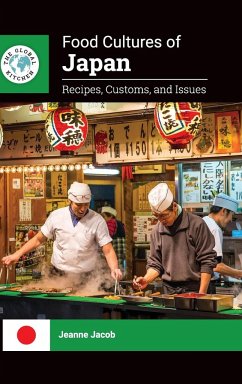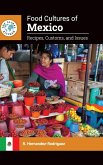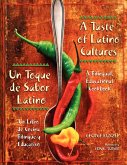- Gebundenes Buch
- Merkliste
- Auf die Merkliste
- Bewerten Bewerten
- Teilen
- Produkt teilen
- Produkterinnerung
- Produkterinnerung
This addition to the Global Kitchen series explores the cuisine of Japan, from culinary history and important ingredients to essential daily and special meals. When we think of Japanese food in the United States, certain images come to mind: sushi, ramen, and hibachi restaurants. But what is food like in this island nation? What do people eat and drink every day? Are food concerns similar to those in the United States, where obesity is a major issue? This volume offers comprehensive coverage on the cuisine of Japan. Readers will learn about the history of food in the country, influential…mehr
Andere Kunden interessierten sich auch für
![Food Cultures of Mexico Food Cultures of Mexico]() R. Hernandez-RodriguezFood Cultures of Mexico70,99 €
R. Hernandez-RodriguezFood Cultures of Mexico70,99 €![Food Cultures of Israel Food Cultures of Israel]() Michael AshkenaziFood Cultures of Israel71,99 €
Michael AshkenaziFood Cultures of Israel71,99 €![Food Cultures of France Food Cultures of France]() Maryann TebbenFood Cultures of France69,99 €
Maryann TebbenFood Cultures of France69,99 €![Food Cultures of the United States Food Cultures of the United States]() Bruce KraigFood Cultures of the United States69,99 €
Bruce KraigFood Cultures of the United States69,99 €![Food Cultures of Great Britain Food Cultures of Great Britain]() Victoria R WilliamsFood Cultures of Great Britain77,99 €
Victoria R WilliamsFood Cultures of Great Britain77,99 €![Food Cultures of China Food Cultures of China]() Qian GuoFood Cultures of China70,99 €
Qian GuoFood Cultures of China70,99 €![A Taste of Latino Cultures/Un Toque de Sabor Latino A Taste of Latino Cultures/Un Toque de Sabor Latino]() George KunzelA Taste of Latino Cultures/Un Toque de Sabor Latino42,99 €
George KunzelA Taste of Latino Cultures/Un Toque de Sabor Latino42,99 €-
-
-
This addition to the Global Kitchen series explores the cuisine of Japan, from culinary history and important ingredients to essential daily and special meals. When we think of Japanese food in the United States, certain images come to mind: sushi, ramen, and hibachi restaurants. But what is food like in this island nation? What do people eat and drink every day? Are food concerns similar to those in the United States, where obesity is a major issue? This volume offers comprehensive coverage on the cuisine of Japan. Readers will learn about the history of food in the country, influential ingredients that play an important role in daily cooking and consumption, meals and dishes for every occasion, and what food is like when dining out or stopping for snacks from street vendors. An additional chapter examines food issues and dietary concerns. Recipes accompany every chapter. A chronology, glossary, sidebars, and bibliography round out the work.
Hinweis: Dieser Artikel kann nur an eine deutsche Lieferadresse ausgeliefert werden.
Hinweis: Dieser Artikel kann nur an eine deutsche Lieferadresse ausgeliefert werden.
Produktdetails
- Produktdetails
- Verlag: ABC-Clio, LLC
- Seitenzahl: 272
- Erscheinungstermin: 31. Dezember 2021
- Englisch
- Abmessung: 240mm x 161mm x 19mm
- Gewicht: 575g
- ISBN-13: 9781440866838
- ISBN-10: 144086683X
- Artikelnr.: 67513994
- Herstellerkennzeichnung
- Libri GmbH
- Europaallee 1
- 36244 Bad Hersfeld
- gpsr@libri.de
- Verlag: ABC-Clio, LLC
- Seitenzahl: 272
- Erscheinungstermin: 31. Dezember 2021
- Englisch
- Abmessung: 240mm x 161mm x 19mm
- Gewicht: 575g
- ISBN-13: 9781440866838
- ISBN-10: 144086683X
- Artikelnr.: 67513994
- Herstellerkennzeichnung
- Libri GmbH
- Europaallee 1
- 36244 Bad Hersfeld
- gpsr@libri.de
Jeanne Jacob is an agronomist and researcher on agroecology. She is coauthor of ABC-CLIO's The World Cookbook: The Greatest Recipes from around the Globe, Revised Edition.
Series Forewordvii
Prefaceix
Introductionxi
Chronologyxvii
Chapter OneFood History1
Chapter TwoInfluential Ingredients25
Chapter ThreeAppetizers and Side Dishes57
Chapter FourMain Dishes75
Chapter FiveDesserts95
Chapter SixBeverages111
Chapter SevenHolidays and Special Occasions129
Chapter EightStreet Food and Snacks147
Chapter NineDining Out165
Chapter TenFood Issues and Dietary Concerns183
Glossary201
Bibliography215
Index223
Series Foreword
Imagine a typical American breakfast: bacon, eggs, toast, and home fries
from the local diner. Or maybe a protein-packed smoothie, sipped on the go
to class or work. In some countries in Europe, breakfast might just be a
small cookie and a strong coffee, if anything at all. A South African
breakfast might consist of a bowl of corn porridge with milk. In Japan,
breakfast might look more like dinner, complete with rice, vegetables, and
fish. What we eat varies from country to country, and even region to
region. The Global Kitchen series explores the cuisines of different
cultures around the world, from the history of food and food staples to
main dishes and contemporary issues. Teeming with recipes to try at home,
these volumes will delight readers by discovering other cultures through
the lens of a treasured topic: food.
Each volume focuses on the culinary heritage of one country or one small
group of countries, covering history and contemporary culture. Volumes
begin with a chronology of major food-related milestones and events in the
area, from prehistory to present. Chapters explore the key foods and meals
in the country, covering the following topics:Food History;
Influential Ingredients;
Appetizers and Side Dishes;
Main Dishes;
Desserts;
Beverages;
Holidays and Special Occasions;
Street Foods and Snacks;
Dining Out; and
Food Issues and Dietary Concerns.
Chapters are textual, and each chapter is accompanied by numerous recipes,
adding a hands-on component to the series. Sidebars, a glossary of
important terms, and a selected bibliography round out each volume,
providing readers with additional information and resources for their
personal and scholarly research needs.
Whether readers are looking for recipes to use for classes or at home, or
to explore the histories and traditions of world cuisines, the Global
Kitchen series will allow readers to fully immerse themselves in other
cultures, giving a taste of typical daily life and tradition.
Preface
What is food like in Japan today? It is certainly not all raw fish, despite
sushi and sashimi topping the list of Japanese diners' favorites. Nor is it
always tempura or steaks on a teppan, the offerings of pioneering Japanese
restaurants outside Japan. Meals vary widely and-perhaps unsurprisingly in
our global age-happily mix local and international dishes, especially in
major urban areas. A weekday family breakfast of toast with butter and jam,
and eggs with sausages, is not unusual. Lunch for an office worker in a
major city such as Tokyo or Osaka could be Vietnamese pho, or Chinese-style
fried rice, or Central Asian-flavored noodles. Supper for a young family is
likely to be the children's choice of hamburger, eaten with rice, at a
family restaurant. In contrast, young working adults prefer to drink and
eat at an izakaya, where specialty seafoods, such as grilled giant shrimp
and crab coral (kani miso), are paired with regional craft sake, as crisp
and dry as white wine. A cold day may be perfect for a nostalgic sweet red
bean "soup" with tiny dumplings, and for the evening, a hot-pot (nabe) of
meat and vegetables, cooked on a tabletop stove. Foods familiar to
Americans and some not so familiar, such as Baumkuchen and choux à la crème
(shu kurimu), are widely available. Neighborhood convenience stores (
kombini) have these and cooked foods too-a hodge-podge stew called oden
simmering away, grilled skewered chicken (yakitori), and meat-filled buns (
nikuman) piping hot. Mukokuseki ("without a nationality") is how many
Japanese describe this eclectic, gastronomic landscape common to urban
areas.
Since the 1960s, once Japan's economy had recovered from the war, the ideal
meal of white rice, miso soup, and pickled vegetables plus two or more side
dishes of fresh (not salted or preserved) fish and seafood or meat and
cooked vegetables had become attainable for the majority. Less than half a
century later, however, many are too busy to prepare such a meal other than
on weekends. Fifty years ago, every component of a traditional meal would
have been prepared from scratch. Each household had its unique way of
fermenting miso and vegetable pickles, imbuing them with what is fondly
known as ofukuro no aji ("the taste of mom's cooking").
Today's lifestyles make the daily re-creation of such meals unfeasible for
working people. The variety of cooked dishes readily bought at reasonable
prices from supermarkets, department store food sections, and convenience
stores makes it too easy not to cook from scratch. Japanese meals today
tend to focus less on rice and fish, and more on chicken, pork, beef, and
dairy products. With the sheer diversity of ingredients imported from all
over the world, nontraditional vegetables, herbs, and other condiments (and
ways of cooking and eating them) have become commonplace, not only in
specialist kitchens and gourmet restaurants, but in the average home
kitchen, too.
Prefaceix
Introductionxi
Chronologyxvii
Chapter OneFood History1
Chapter TwoInfluential Ingredients25
Chapter ThreeAppetizers and Side Dishes57
Chapter FourMain Dishes75
Chapter FiveDesserts95
Chapter SixBeverages111
Chapter SevenHolidays and Special Occasions129
Chapter EightStreet Food and Snacks147
Chapter NineDining Out165
Chapter TenFood Issues and Dietary Concerns183
Glossary201
Bibliography215
Index223
Series Foreword
Imagine a typical American breakfast: bacon, eggs, toast, and home fries
from the local diner. Or maybe a protein-packed smoothie, sipped on the go
to class or work. In some countries in Europe, breakfast might just be a
small cookie and a strong coffee, if anything at all. A South African
breakfast might consist of a bowl of corn porridge with milk. In Japan,
breakfast might look more like dinner, complete with rice, vegetables, and
fish. What we eat varies from country to country, and even region to
region. The Global Kitchen series explores the cuisines of different
cultures around the world, from the history of food and food staples to
main dishes and contemporary issues. Teeming with recipes to try at home,
these volumes will delight readers by discovering other cultures through
the lens of a treasured topic: food.
Each volume focuses on the culinary heritage of one country or one small
group of countries, covering history and contemporary culture. Volumes
begin with a chronology of major food-related milestones and events in the
area, from prehistory to present. Chapters explore the key foods and meals
in the country, covering the following topics:Food History;
Influential Ingredients;
Appetizers and Side Dishes;
Main Dishes;
Desserts;
Beverages;
Holidays and Special Occasions;
Street Foods and Snacks;
Dining Out; and
Food Issues and Dietary Concerns.
Chapters are textual, and each chapter is accompanied by numerous recipes,
adding a hands-on component to the series. Sidebars, a glossary of
important terms, and a selected bibliography round out each volume,
providing readers with additional information and resources for their
personal and scholarly research needs.
Whether readers are looking for recipes to use for classes or at home, or
to explore the histories and traditions of world cuisines, the Global
Kitchen series will allow readers to fully immerse themselves in other
cultures, giving a taste of typical daily life and tradition.
Preface
What is food like in Japan today? It is certainly not all raw fish, despite
sushi and sashimi topping the list of Japanese diners' favorites. Nor is it
always tempura or steaks on a teppan, the offerings of pioneering Japanese
restaurants outside Japan. Meals vary widely and-perhaps unsurprisingly in
our global age-happily mix local and international dishes, especially in
major urban areas. A weekday family breakfast of toast with butter and jam,
and eggs with sausages, is not unusual. Lunch for an office worker in a
major city such as Tokyo or Osaka could be Vietnamese pho, or Chinese-style
fried rice, or Central Asian-flavored noodles. Supper for a young family is
likely to be the children's choice of hamburger, eaten with rice, at a
family restaurant. In contrast, young working adults prefer to drink and
eat at an izakaya, where specialty seafoods, such as grilled giant shrimp
and crab coral (kani miso), are paired with regional craft sake, as crisp
and dry as white wine. A cold day may be perfect for a nostalgic sweet red
bean "soup" with tiny dumplings, and for the evening, a hot-pot (nabe) of
meat and vegetables, cooked on a tabletop stove. Foods familiar to
Americans and some not so familiar, such as Baumkuchen and choux à la crème
(shu kurimu), are widely available. Neighborhood convenience stores (
kombini) have these and cooked foods too-a hodge-podge stew called oden
simmering away, grilled skewered chicken (yakitori), and meat-filled buns (
nikuman) piping hot. Mukokuseki ("without a nationality") is how many
Japanese describe this eclectic, gastronomic landscape common to urban
areas.
Since the 1960s, once Japan's economy had recovered from the war, the ideal
meal of white rice, miso soup, and pickled vegetables plus two or more side
dishes of fresh (not salted or preserved) fish and seafood or meat and
cooked vegetables had become attainable for the majority. Less than half a
century later, however, many are too busy to prepare such a meal other than
on weekends. Fifty years ago, every component of a traditional meal would
have been prepared from scratch. Each household had its unique way of
fermenting miso and vegetable pickles, imbuing them with what is fondly
known as ofukuro no aji ("the taste of mom's cooking").
Today's lifestyles make the daily re-creation of such meals unfeasible for
working people. The variety of cooked dishes readily bought at reasonable
prices from supermarkets, department store food sections, and convenience
stores makes it too easy not to cook from scratch. Japanese meals today
tend to focus less on rice and fish, and more on chicken, pork, beef, and
dairy products. With the sheer diversity of ingredients imported from all
over the world, nontraditional vegetables, herbs, and other condiments (and
ways of cooking and eating them) have become commonplace, not only in
specialist kitchens and gourmet restaurants, but in the average home
kitchen, too.
Series Forewordvii
Prefaceix
Introductionxi
Chronologyxvii
Chapter OneFood History1
Chapter TwoInfluential Ingredients25
Chapter ThreeAppetizers and Side Dishes57
Chapter FourMain Dishes75
Chapter FiveDesserts95
Chapter SixBeverages111
Chapter SevenHolidays and Special Occasions129
Chapter EightStreet Food and Snacks147
Chapter NineDining Out165
Chapter TenFood Issues and Dietary Concerns183
Glossary201
Bibliography215
Index223
Series Foreword
Imagine a typical American breakfast: bacon, eggs, toast, and home fries
from the local diner. Or maybe a protein-packed smoothie, sipped on the go
to class or work. In some countries in Europe, breakfast might just be a
small cookie and a strong coffee, if anything at all. A South African
breakfast might consist of a bowl of corn porridge with milk. In Japan,
breakfast might look more like dinner, complete with rice, vegetables, and
fish. What we eat varies from country to country, and even region to
region. The Global Kitchen series explores the cuisines of different
cultures around the world, from the history of food and food staples to
main dishes and contemporary issues. Teeming with recipes to try at home,
these volumes will delight readers by discovering other cultures through
the lens of a treasured topic: food.
Each volume focuses on the culinary heritage of one country or one small
group of countries, covering history and contemporary culture. Volumes
begin with a chronology of major food-related milestones and events in the
area, from prehistory to present. Chapters explore the key foods and meals
in the country, covering the following topics:Food History;
Influential Ingredients;
Appetizers and Side Dishes;
Main Dishes;
Desserts;
Beverages;
Holidays and Special Occasions;
Street Foods and Snacks;
Dining Out; and
Food Issues and Dietary Concerns.
Chapters are textual, and each chapter is accompanied by numerous recipes,
adding a hands-on component to the series. Sidebars, a glossary of
important terms, and a selected bibliography round out each volume,
providing readers with additional information and resources for their
personal and scholarly research needs.
Whether readers are looking for recipes to use for classes or at home, or
to explore the histories and traditions of world cuisines, the Global
Kitchen series will allow readers to fully immerse themselves in other
cultures, giving a taste of typical daily life and tradition.
Preface
What is food like in Japan today? It is certainly not all raw fish, despite
sushi and sashimi topping the list of Japanese diners' favorites. Nor is it
always tempura or steaks on a teppan, the offerings of pioneering Japanese
restaurants outside Japan. Meals vary widely and-perhaps unsurprisingly in
our global age-happily mix local and international dishes, especially in
major urban areas. A weekday family breakfast of toast with butter and jam,
and eggs with sausages, is not unusual. Lunch for an office worker in a
major city such as Tokyo or Osaka could be Vietnamese pho, or Chinese-style
fried rice, or Central Asian-flavored noodles. Supper for a young family is
likely to be the children's choice of hamburger, eaten with rice, at a
family restaurant. In contrast, young working adults prefer to drink and
eat at an izakaya, where specialty seafoods, such as grilled giant shrimp
and crab coral (kani miso), are paired with regional craft sake, as crisp
and dry as white wine. A cold day may be perfect for a nostalgic sweet red
bean "soup" with tiny dumplings, and for the evening, a hot-pot (nabe) of
meat and vegetables, cooked on a tabletop stove. Foods familiar to
Americans and some not so familiar, such as Baumkuchen and choux à la crème
(shu kurimu), are widely available. Neighborhood convenience stores (
kombini) have these and cooked foods too-a hodge-podge stew called oden
simmering away, grilled skewered chicken (yakitori), and meat-filled buns (
nikuman) piping hot. Mukokuseki ("without a nationality") is how many
Japanese describe this eclectic, gastronomic landscape common to urban
areas.
Since the 1960s, once Japan's economy had recovered from the war, the ideal
meal of white rice, miso soup, and pickled vegetables plus two or more side
dishes of fresh (not salted or preserved) fish and seafood or meat and
cooked vegetables had become attainable for the majority. Less than half a
century later, however, many are too busy to prepare such a meal other than
on weekends. Fifty years ago, every component of a traditional meal would
have been prepared from scratch. Each household had its unique way of
fermenting miso and vegetable pickles, imbuing them with what is fondly
known as ofukuro no aji ("the taste of mom's cooking").
Today's lifestyles make the daily re-creation of such meals unfeasible for
working people. The variety of cooked dishes readily bought at reasonable
prices from supermarkets, department store food sections, and convenience
stores makes it too easy not to cook from scratch. Japanese meals today
tend to focus less on rice and fish, and more on chicken, pork, beef, and
dairy products. With the sheer diversity of ingredients imported from all
over the world, nontraditional vegetables, herbs, and other condiments (and
ways of cooking and eating them) have become commonplace, not only in
specialist kitchens and gourmet restaurants, but in the average home
kitchen, too.
Prefaceix
Introductionxi
Chronologyxvii
Chapter OneFood History1
Chapter TwoInfluential Ingredients25
Chapter ThreeAppetizers and Side Dishes57
Chapter FourMain Dishes75
Chapter FiveDesserts95
Chapter SixBeverages111
Chapter SevenHolidays and Special Occasions129
Chapter EightStreet Food and Snacks147
Chapter NineDining Out165
Chapter TenFood Issues and Dietary Concerns183
Glossary201
Bibliography215
Index223
Series Foreword
Imagine a typical American breakfast: bacon, eggs, toast, and home fries
from the local diner. Or maybe a protein-packed smoothie, sipped on the go
to class or work. In some countries in Europe, breakfast might just be a
small cookie and a strong coffee, if anything at all. A South African
breakfast might consist of a bowl of corn porridge with milk. In Japan,
breakfast might look more like dinner, complete with rice, vegetables, and
fish. What we eat varies from country to country, and even region to
region. The Global Kitchen series explores the cuisines of different
cultures around the world, from the history of food and food staples to
main dishes and contemporary issues. Teeming with recipes to try at home,
these volumes will delight readers by discovering other cultures through
the lens of a treasured topic: food.
Each volume focuses on the culinary heritage of one country or one small
group of countries, covering history and contemporary culture. Volumes
begin with a chronology of major food-related milestones and events in the
area, from prehistory to present. Chapters explore the key foods and meals
in the country, covering the following topics:Food History;
Influential Ingredients;
Appetizers and Side Dishes;
Main Dishes;
Desserts;
Beverages;
Holidays and Special Occasions;
Street Foods and Snacks;
Dining Out; and
Food Issues and Dietary Concerns.
Chapters are textual, and each chapter is accompanied by numerous recipes,
adding a hands-on component to the series. Sidebars, a glossary of
important terms, and a selected bibliography round out each volume,
providing readers with additional information and resources for their
personal and scholarly research needs.
Whether readers are looking for recipes to use for classes or at home, or
to explore the histories and traditions of world cuisines, the Global
Kitchen series will allow readers to fully immerse themselves in other
cultures, giving a taste of typical daily life and tradition.
Preface
What is food like in Japan today? It is certainly not all raw fish, despite
sushi and sashimi topping the list of Japanese diners' favorites. Nor is it
always tempura or steaks on a teppan, the offerings of pioneering Japanese
restaurants outside Japan. Meals vary widely and-perhaps unsurprisingly in
our global age-happily mix local and international dishes, especially in
major urban areas. A weekday family breakfast of toast with butter and jam,
and eggs with sausages, is not unusual. Lunch for an office worker in a
major city such as Tokyo or Osaka could be Vietnamese pho, or Chinese-style
fried rice, or Central Asian-flavored noodles. Supper for a young family is
likely to be the children's choice of hamburger, eaten with rice, at a
family restaurant. In contrast, young working adults prefer to drink and
eat at an izakaya, where specialty seafoods, such as grilled giant shrimp
and crab coral (kani miso), are paired with regional craft sake, as crisp
and dry as white wine. A cold day may be perfect for a nostalgic sweet red
bean "soup" with tiny dumplings, and for the evening, a hot-pot (nabe) of
meat and vegetables, cooked on a tabletop stove. Foods familiar to
Americans and some not so familiar, such as Baumkuchen and choux à la crème
(shu kurimu), are widely available. Neighborhood convenience stores (
kombini) have these and cooked foods too-a hodge-podge stew called oden
simmering away, grilled skewered chicken (yakitori), and meat-filled buns (
nikuman) piping hot. Mukokuseki ("without a nationality") is how many
Japanese describe this eclectic, gastronomic landscape common to urban
areas.
Since the 1960s, once Japan's economy had recovered from the war, the ideal
meal of white rice, miso soup, and pickled vegetables plus two or more side
dishes of fresh (not salted or preserved) fish and seafood or meat and
cooked vegetables had become attainable for the majority. Less than half a
century later, however, many are too busy to prepare such a meal other than
on weekends. Fifty years ago, every component of a traditional meal would
have been prepared from scratch. Each household had its unique way of
fermenting miso and vegetable pickles, imbuing them with what is fondly
known as ofukuro no aji ("the taste of mom's cooking").
Today's lifestyles make the daily re-creation of such meals unfeasible for
working people. The variety of cooked dishes readily bought at reasonable
prices from supermarkets, department store food sections, and convenience
stores makes it too easy not to cook from scratch. Japanese meals today
tend to focus less on rice and fish, and more on chicken, pork, beef, and
dairy products. With the sheer diversity of ingredients imported from all
over the world, nontraditional vegetables, herbs, and other condiments (and
ways of cooking and eating them) have become commonplace, not only in
specialist kitchens and gourmet restaurants, but in the average home
kitchen, too.








